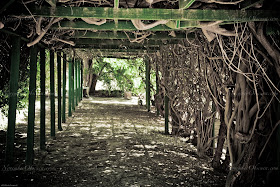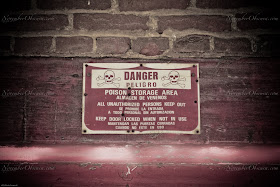

A few months ago Jeff and I took a drive along highway 126 which travels in part from the Castaic area to the city of Ventura at the coast. One of the things we found along the 126 is Rancho Camulos. It is said to be the inspiration for the much loved story 'Ramona'. On the day we went- the hacienda was actually closed, but since it remains a working ranch, we were able to walk around the 'working' parts of the property. As always I have included a little history of the Rancho among the photos.

Rancho Camulos, now known as Rancho Camulos Museum, is a ranch located 2.2 miles (3.5 km) east of Piru, California. It was the home of Ygnacio del Valle, an alcalde of Los Angeles and member of the California State Assembly. The ranch was known as the Home of Ramona because it was widely believed to have been the setting of the popular 1884 novel Ramona by Helen Hunt Jackson. The novel helped in raising awareness about the Californio lifestyle and "romanticizing of the mission and rancho era of California history."
The 1,800-acre (7 km2) working ranch is a prime example of an early California rancho in its original rural setting. It was the source of the first commercially grown oranges in what is now Ventura County, and is one of the few remaining citrus growers in Southern California.


State Route 126 bisects the property, with most of the main buildings located south of the highway, and a few buildings on the north. The main adobe is one of the few extant Spanish Colonial buildings left in the state. Most of the other buildings are done in Mission Revival or Spanish Colonial Revival, both of which are derivatives of the former.
Rancho Camulos is designated a National Historic Landmark, listed on the National Register of Historic Places, and is also a California Historical Landmark. Many of the buildings and grounds are open to the public as a museum of this period in California history.

Originally a Tataviam village named Kamulus (meaning "juniper"), the area was used by Mission San Fernando Rey de España for growing crops and as a grazing area for livestock as early as 1804. The population of this relatively isolated area (only traversed by the El Camino Real), as recorded by William Edward Petty Hartnell during his inspection of the mission, was 416 in 1839. It was included in the 48,612-acre (197 km2) Rancho San Francisco granted to Del Valle's father, Antonio del Valle, administrator of Mission San Fernando, by Governor Juan B. Alvarado on January 22, 1839, after the secularization of the missions.

After Antonio's death in 1841, Ygnacio inherited Rancho San Francisco, but this was challenged in court by his father's second wife. Nevertheless, by 1853 he constructed a four-room adobe house and a corral at Camulos. By 1857, the land title dispute was settled, with Ygnacio getting the western portion and the remainder was split among Antonio's children and his second wife. He purchased back some of the other portions from his family as well as the neighboring Rancho Temescal to the north, and began livestock operations on the expanded area. However, Del Valle and his family did not live on the ranch initially, instead settling in house on what is now Olvera Street in Los Angeles. The Del Valle family did not move back to Camulos, which he had expanded, until 1861. During this time, the ranch was overseen by José Antonio Salazar, Ygnacio's majordomo. Thus, despite its close association with Ramona and Mexican California, the house was constructed after California statehood and the family never lived there under Mexican rule.

In the 1860s, a drought forced Del Valle to sell off much of his land, but Camulos not only survived, but thrived. By the time of his death in 1880, the house had expanded to twenty rooms and the compound had become a self-sustaining ranch, complete with a brick winery, chapel, barn and workers' housing. Records indicate that in 1870 the ranch was largest vintner in the area. A stagecoach line opened in 1874 and in 1887, Southern Pacific ran a rail line past the ranch, including a depot at Camulos, ending the ranch's isolation.


My wife and I are docents at the museum and I am the current Site Manager for the museum. We were impressed with you beautiful photos and the accuracy of your narative. We encouage you to visit again during our open hours on Wednesdays, Saturdays and Sundays between 1 and 4 p.m.
ReplyDeleteJack Infranca
Thank you so much Jack- we certainly shall do that!
ReplyDelete~W~